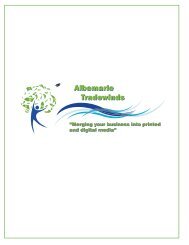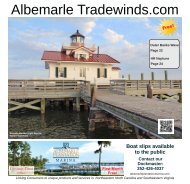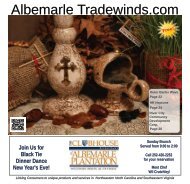Albemarle Tradewinds February 2020 Web Final
February edition of the Tradewinds now online
February edition of the Tradewinds now online
You also want an ePaper? Increase the reach of your titles
YUMPU automatically turns print PDFs into web optimized ePapers that Google loves.
Chowanoke History<br />
by Duvonya Chavis<br />
Many people are unaware that certain U.S. Navy ships are<br />
named after American Indian Tribes. Ship naming conventions<br />
were established in the 1800’s by Congress in Title 13, Chapter 6<br />
of the United States Code and allow the Secretary of the Navy to<br />
name the Navy’s vessels following certain rules. Specifically, ocean<br />
fleet tugs and harbor tugs are named after American Indian tribes<br />
and the highest honor a Secretary of the Navy can bestow is in the<br />
naming of a ship.<br />
With that being said, few know that a US Navy ATF ship was named<br />
after the Chowanoc (Chowanoke) Tribe. Of the many possible Tribal<br />
names considered, the USS Chowanoc (ATF-100) was part of the<br />
Abnaki Class of Ocean Fleet Tugs that consisted of twenty-two<br />
ships. Fleet Ocean Tugs are used to tow ships, perform rescue<br />
missions, clean up ocean oil spills and conduct various other naval<br />
exercises or missions.<br />
The USS Chowanoc was commissioned in 1944 and was used<br />
extensively during World War II, the Korean War, and the Vietnam<br />
War. It earned the Navy Unit Commendation for service in Salvage,<br />
Fire Fighting, and Rescue Unit in Philippine Islands, four battle stars<br />
for its services during World War II, one battle star during the Korean<br />
War, and seven campaign stars during Vietnam War.<br />
The USS Chowanoc was decommissioned in 1977 and sold to Ecuador.<br />
The other Ocean Fleet Tugs in the Abnaki Class were likewise<br />
decommissioned and most were sold to various countries in South<br />
America, with a couple remaining stateside or lost. The Abnaki Class<br />
of Ocean Fleet Tugs have since been succeeded by the Powhatan<br />
Class of Ocean Fleets Tugs, which consisted only of seven ships.<br />
Only four are currently active.<br />
National Archives Photo<br />
Duvonya, a Chowanoke<br />
descendant, is President of<br />
Roanoke-Chowan Native<br />
American Association, a<br />
non-profit organization whose<br />
mission is to help American<br />
Indians in Northeastern NC<br />
and Southeastern VA. In<br />
partnership with another<br />
Chowanoke descendant, she<br />
is currently developing the<br />
historic Chowanoke Reservation<br />
in Gates County for<br />
Tribal descendants to hold<br />
cultural events.<br />
Did you know the<br />
<strong>Albemarle</strong> <strong>Tradewinds</strong><br />
is located in more than<br />
250 locations in NENC<br />
and Chesapeake?<br />
Pet Partners<br />
(NewsUSA) - By gaining a better understanding of the allergies<br />
caused by pets, you may be able to find a healthier<br />
coexistence with your furry friend.<br />
shed the least fur and/or are the most frequently bathed.<br />
Also, smaller dogs produce less saliva than do<br />
bigger dogs.<br />
According to The Humane Society, 62 percent of American<br />
households have at least one pet. Yet, an estimated 31<br />
million Americans are allergic to animals, including up to 30<br />
percent of those who have asthma. Here’s what you should<br />
know about pet allergies:<br />
Myth 1: It’s only pet hair that causes allergies to flare up.<br />
Not true. Pet hair is a nuisance and causes allergies, as it<br />
contains saliva or other pet proteins. Allergic reactions to<br />
pets are actually caused by pet proteins contained in pet<br />
dander, such as microscopic skin flakes, saliva and urine.<br />
Overactive immune systems in those with allergies attack<br />
these otherwise harmless substances.<br />
Myth 2: Continuous exposure to animals will eventually<br />
desensitize you to them.<br />
Not only is this not true, but in some cases the opposite is<br />
true. If you have a confirmed allergy to animals, it usually<br />
will not get better through increasing exposure. In fact,<br />
it may get worse.<br />
Myth 3: With the right pet breed, allergy problems go away.<br />
Not true. All cat or dog breeds produce dander. However,<br />
some breeds are believed to be better for allergy sufferers<br />
than other breeds. Typically the best breeds are those that<br />
Myth 4: Small animals are not a problem for allergies.<br />
Wrong. Hamsters, guinea pigs, birds and other warm-blooded<br />
mammals can also trigger asthma and allergies in people<br />
with allergies to animal dander, according to the U.S.<br />
Environmental Protection Agency.<br />
Myth 5: Outside the home, you shouldn’t have pet allergies.<br />
Not necessarily. Because of their microscopic size and jagged<br />
shape, pet allergens easily stick to clothing and other<br />
fabrics and are carried to other locations. Animal dander<br />
-- in sufficient levels to cause allergies -- can be found in<br />
many public places such as the workplace,<br />
classrooms and hospitals, according to the American Lung<br />
Association.<br />
Myth 6: An air purifier will help with pet allergies.<br />
It depends on the air purifier. Only a high-performance air<br />
purifier can help. Some allergy sufferers report that small,<br />
low-quality air cleaners make little or no difference at all.<br />
However, many allergy sufferers report that their IQAir air<br />
purifier, in combination with improved cleaning methods,<br />
has reduced or completely eliminated their allergic reactions<br />
to pets in their homes.<br />
For more information, visit the IQAir website at<br />
www.iqair.com.<br />
12 <strong>Albemarle</strong> <strong>Tradewinds</strong> <strong>February</strong> <strong>2020</strong> albemarletradewinds.com
















